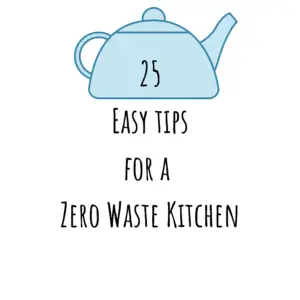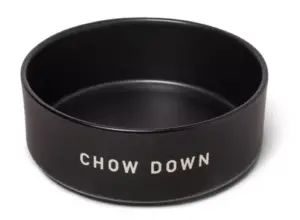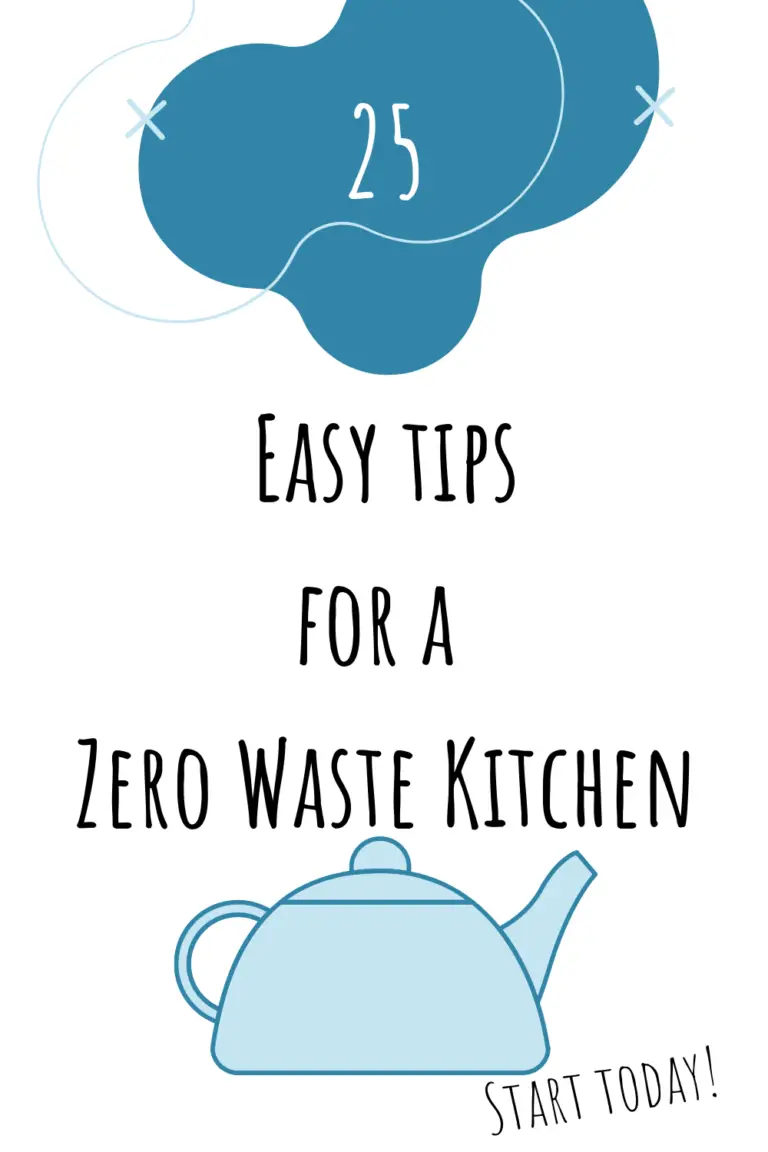

Living a zero waste lifestyle is quite a daunting task.
The kitchen is a great place to start. Most kitchens create a ton of waste!
We are not claiming to be 100% zero waste ourselves, but we’ve implemented many changes (especially in the kitchen) over the years in striving for a more sustainable and zero waste lifestyle.
Zero waste is a lifestyle that aims to minimize the items thrown away. Instead, it promotes buying less and using products that can be reused, composted or recycled (as a last resort).
Note: This post may contain affiliate links. What does this mean?
Here are 25 easy tips for a zero waste kitchen:
If coffee is a major food group in your life, then consider a coffee maker that comes with a reusable coffee filter or one where you can purchase a reusable coffee filter.
For instance, this Ninja coffee maker does not require single-use coffee filters. If you’re obsessed with your single-cup Keurig machine, then replace those single-use pods with this reusable one! If you have a more simple machine like a basic Mr. Coffee maker, they make reusable coffee filters for those too!
Another good option for ditching the single-use coffee pods/filters, is getting a coffee press.
Food waste is probably one of the biggest culprits to waste in the kitchen. Before heading to the store, shop your pantry and fridge and make sure you’re using up food before it goes bad.

If you have dog, feed them food scraps – as long as they’re safe! Many high-end brands of dog food contain fresh ingredients including carrots, peas, potatoes and meats. So next time you’re peeling carrots, stick those peels in your dogs food bowl.
Whatever produce scraps we make that we don’t feed to our dogs, we compost! Composting can drastically reduce your kitchen waste – especially if you’re a healthy eater! Turn those eggs shells and banana peels into nutrient-rich soil. We love the modern look of this countertop compost bin – but you really can go without. Though not as pretty, we often use old plastic salad containers to hold our compost scraps before taking them outside. We also have this outdoor tumbling compost bin. It’s super easy to use and perfect for those who want to start composting.
Use cloth napkins and paper towels. We love these “unpaper towels” we found on Etsy from the shop “marleysmonsters“. You can even get them on this wooden towel holder, making the transition from paper towels to unpaper towels more seemless.
No more plastic straws! Buying reusable straws is a super affordable and easy way to reduce waste in the kitchen. There are ones made of silicone and stainless steel – our favorite are the silicone ones, especially for kids as they are safer.
Doing dishes is just a part of life. Ditch those plastic green and yellow sponges – they’re bad for the environment. There are tons of plastic-free sponges on the market. This is one of our favorites – the Coffee Squeeze by Rowenstillwater (you can buy them on Etsy!). It’s reusable, sustainable, and plastic free. It’s made from recycled fair trade coffee sacks, cellulose and cotton. When the sponge reaches the end of its life, simply add it to the compost bin!
Everyone has them…not everyone remembers to use them. Using your reusable grocery bags cuts down on waste.
Ditch the single-use aluminum foil or parchment paper and opt for a reusable silicone baking mat. There are tons of brand on the market (OXO, KitchenAid, etc.), but we like this cheap Target brand one!
Replacing those plastic ziploc bags with reusable bags is another super easy and affordable way to make your kitchen more zero waste. Over time, they pay for themselves. Our favorite brand is Stasher – they come in a variety of sizes and fun colors. Plus, they are easy to find (you can find them at Target!).
Is Saran Wrap and aluminum foil your go-to for storing leftovers?
Instead, get reusable containers for leftovers. Opt for glass over plastic. We like the Pyrex brand – not only are they great for storing leftovers, they can also be used to bake with and put in the freezer. We love a multi-purpose item!
There’s often less packaging when you buy in bulk. Buy the bigger bag of rice. Buy the big container of apple sauce vs. the individual portions. Even better is when you can buy from the ‘bulk’ section in the grocery store with your own reusable bags.
Not all food packaging can be reused, but some can! We like to save glass jars for either drinking out of or for food storage. We like to save big sturdy boxes for organzation projects. We will sometimes give an empty box of pasta or crackers a brief second life by letting our preschooler play with it (who needs pretend food!?).
Recycling is often considered the last resort for living a zero waste lifestyle. First, you want to strive to use less and reuse.
However, when it comes to recycling, there are simple steps you can make that will make recycling easier.
Your recycle bin should be easily accessible from the kitchen. An easily accessible recycle bin will help ensure that recyclables actually get recycled. This is especially important when there are multiple members in your household, including children. If the trash can is closer and you have to walk farther to get to the recycle bin, then this may deter people from recycling. Put your recycle bin closer than the trash can or next to the trash can.
Secondly, make sure you have a large enough recycle bin or empty it regularly. An overflowing recycle bin, will again, deter people from using it.
Instead of pouring a whole pot of boiling water down the sink, consider reusing that pasta water. Did you know boiling water makes a great non-toxic weed killer? Or let it cool and use it to water plants or soak dirty dishes.
Cooking with dried beans is simpler than you think! A large bag of beans will go a long way and can replace dozens and dozens of canned beans.
Another way you can reduce the use of canned foods is by using fresh tomatoes instead of canned tomatoes. In similar fashion, look at any canned food items you frequently use and swap with the fresh version.
Instead of using the plastic produce bags at the grocery store (which just get thrown out when you get home), invest in some cheap reusable produce bags.
Making food from scratch instead of buying it pre-made. Frozen pizza, pasta sauces, hummus….these are all common items that many people buy pre–made but can be quite easy to make from scratch. Of course, the complexity of the food you make at home is dependent on how much time you have as well as skill. Some families may be able to make their own bread and pasta, while for others, this simply isn’t practicable.
Any food you can grow yourself will dramatically reduce waste – even if you buy produce with no packaging or reusable packaging, think of all the resources it takes to get the produce from farm to table.
Speaking from personal experience, growing basil is almost fool-proof, even for those with black thumbs.
Gardening really does take skill. If traditional gardening isn’t your thing, consider getting a hydroponic vertical garden like the Lettuce Grow Farmstand.
We love our cast iron skillet and think it should be a staple in everyones kitchen. One major benefit to using cast iron is that it’s better for your health than teflon or non-stick cookware. However, one often overlooked benefit to cast iron cookware is that it is zero waste. No soap needed to clean cast iron!
Those pre-cut fruits and veggies in the grocery store sure are convenient – especially for those annoying to cut pineapples and onions! But they’re also super wasteful when it comes to packaging.
Part of the zero waste movement is buying less. Don’t fall for gimmicky, single-use products. There are special individual products for cutting apples, avocados, herbs, hard-boiled eggs, etc. For us, a knife works just the same. Think long and hard before you buy a kitchen item – do you already own something that can accomplish the same result?
One major culprit of waste in the kitchen is food waste, as mentioned above. You’ve spent time, money and effort making food, so spend just as much effort making sure those leftovers don’t go to waste. Be diligent in eating leftovers or freezing them for another time!
You can have the most zero waste and sustainable kitchen, but if you end up picking up food or drinks from a drive-thru, it’s like taking 10 steps back. There is so much waste in fast food and take-out. We do enjoy the occasional fast-food and take-out just like everyone else, but we try to make it intentional – not an after thought. So plan ahead if you know you’re going to be out and about. Bring drinks and snacks (in your reusable containers). This way, you’re not turning to a drive-thru out of desperation and poor planning.
So there you have it! 25 easy tips for a zero waste kitchen! Some things are free while some require an investment. Which one of these can you start today? Follow us on Instagram for more. Pin for later!


Check out our most recent articles: